The old town centre
Dragon's town of the enterprising and the skilled
It all began with the dragon. He came to life deep inside the mountain of Košuta. When he grew into a huge beast it split the mountain in two. This triggered a rumbling rock avalanche that buried the settlement below the mountain. To save themselves the inhabitants ran into the valley. After a time they ran out of breath and stopped. This is where the present-day town of Tržič grew and developed.
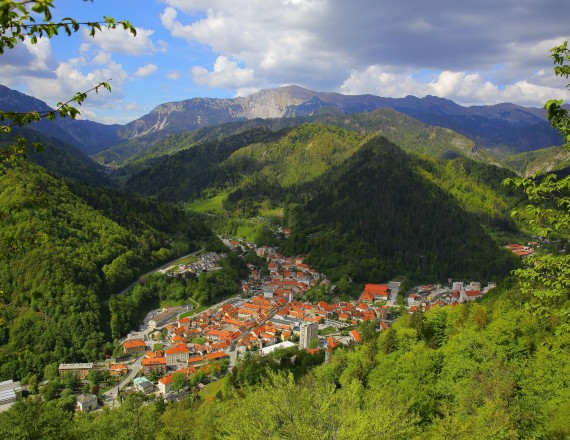 1 / 10 The old town centre
1 / 10 The old town centre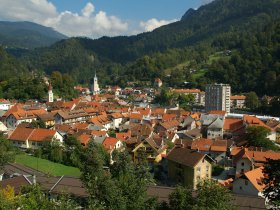 2 / 10 The old town centre (Samo P...
2 / 10 The old town centre (Samo P...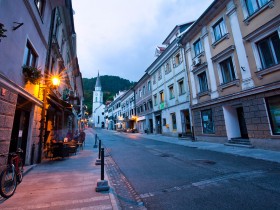 3 / 10 Trg svobode (Jošt Gantar)
3 / 10 Trg svobode (Jošt Gantar)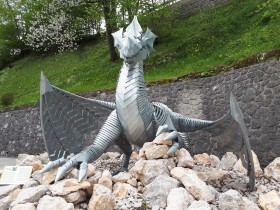 4 / 10 The dragon from the rooster...
4 / 10 The dragon from the rooster...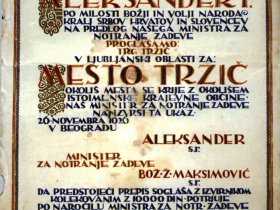 5 / 10 Tržič was elevated from a m...
5 / 10 Tržič was elevated from a m...
It was a long time ago.
So long ago that in 1492, exactly two months after Columbus discovered America, Tržič was no longer a village, but a market town. Every couple of centuries Tržič was reconstructed after burning to the ground in a fire. For this reason it is today the only town with a 200-year-old tradition of fire protection and the mandatory use at that time of metal doors and shutters.
This is a town famous for its tradition of craftsmanship.
Since this area has been a busy transportation route since the time of ancient Rome, the residents of Tržič developed into outstanding and very enterprising ironworkers, cartwrights, clothmakers, tanners, and especially shoemakers. This is attested to by the rich collection in the Tržič Museum. Today Tržič is a pleasant old town, protected as a cultural monument.
So what happened to the dragon?
That dragon that was responsible for the creation of Tržič? He was buried by that same rockslide that he himself triggered. A lucky thing, too – otherwise he'd still be frightening visitors to Tržič.
(Re)Discover Tržič with Adele in Slovenia
history of the town
Tržič is the only market town in Carniola that has preserved the founding charter that elevated it in 1492 to the status of market town. Its development has been closely tied to the route leading from the plains of Gorenjska (Upper Carniola) across Ljubelj (Loibl) pass to Carinthia.
Archeological finds show that this route existed back in ancient history when Virunum in Zollfeld was connected with Emona by way of Ljubelj (Loibl). The Ljubelj market (Forum in Lubelino) was located along the route but it was buried by a landslide and so some of the inhabitants moved into the valley, where they founded the settlement of Neumarktl. The settlement began to develop at the foot of a hill where at first there was a mansion and later the castle of Neuhaus. Its development and shape were dictated by the traffic arterial and the developing crafts of smithing and ironworking.
In 1492 Tržič became a market town.
At the end of the 15th century the needs for an organized market were great and a founding act was required to give the settlement the status of a market. In 1492 Emperor Frederick III, at the request of the then owners of Tržič, elevated the village of Tržič – Neumarktl to a market town. Thus there were a large number of weekly and also annual fairs, of which the most important were Andrew's Fair in advance of St. Nicholas Day and the fair for the memorial of the Holy Guardian Angels (the first Sunday in September).
Severe fire in 1811
Tržič's greatest catastrophe hit the town in 1811, when a terrible fire broke out and the smithies, forges, and numerous craft workshops and town houses burned to the ground, unless they were protected by stone sides. The fire resulted in the destruction of 150 houses and more than 60 workshops as well as the loss of 75 lives.
The rebuilding of Tržič after the fire took place slowly. Because of the fire a special regulation was imposed requiring the mandatory installation of metal doors and shutters, which became a special European feature. The main square has retained its essential appearance to this day. Tržič's status was raised from a market town to a city in 1926 by Alexander I, King of the Serbs, Croats, and Slovenes.
Cultural and historical monument
The old town centre of Tržič has been protected as a cultural and historical monument since 1985. The buildings with their medieval floor plan, with a workshop, storehouse, and connecting hallway on the ground floor, have preserved their classicist design in a row of facades since the 1811 fire. All the buildings also have a few other common features that were preserved after the rebuilding of the town:
- portals decorated with rosettes bearing the year they were made, the initials of the owner of the house and a God's eye containing the house number, and window frames made from green Perast stone,
- wrought iron shutters, screens, and doors, in order to prevent the spread of fire through the town,
- a "firb'c" (prying) window (the only one still preserved is at 1 Koroška Road); through such a window Tržič ladies or "Frauen" had a view of the goings-on in the street without having to lean out the window,
- a drying hole in the roof, for drying hides, canvas, and socks,
- roadside rocks called "opestniki" (hubstones), so called after the hub (pesto) of the wheel of a cart, which would hit the hubstone instead of the facade of the building and thereby protect the latter from damage.
The buildings in the old town centre are also interesting due to the people who lived in them and to their architectural characteristics.
SUMMER GUIDED TOURS 29.6.-31.8.2024: during the summer holidays, guided tours of the city centre take place every Friday at 10 am. Tickets cost EUR 5/person, pre-school children are free of charge.
CONTACT AND FURTHER INFORMATION
TPIC Tržič, Trg svobode 18, 4290 Tržič
T: 04 59 71 536 / 051 627 057
E: informacije@trzic.si
A guided tour can be arranged with TPIC Tržič and Tržič museum (+386 4 5315 500; +386 31 337 311 and trziski.muzej@guest.arnes.si)
Entrance fee
Required only for guided tours.
- groups with more than 12 people: children, students, retired: 4.00 EUR/person, adults 5.00 EUR/person
- groups with less than 12 people: 62.00 EUR/group
- school groups and retired to 15 people: 55.00 EUR/group
